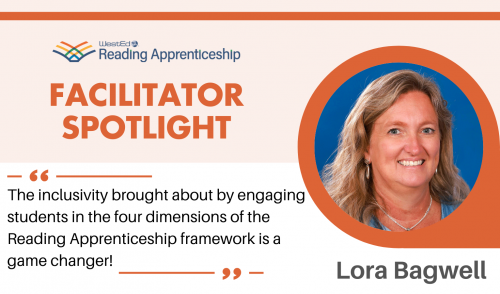Location: Knoxville, TN
Years of Teaching: 20
If you had to describe yourself as an educator, what six words would you use and why?
Engaged, purposeful, explorer, listener, strategic and sympathetic
These are the traits I like to see in my students, and I cannot ask them to do anything that I am not willing to do myself.
Engaged–The routines and strategies associated with the Reading Apprenticeship framework require students and instructors to be engaged with the text and one another.
Purposeful—Students need to see a purpose in the work I am asking them to do. My learning opportunities need to help students see how the reading and college success strategies are applicable to other classes and to their personal lives.
Explorer, listener, and strategic– The Intelligent Practice Formula is an important part of my co-requisite courses along with the Reading Apprenticeship framework. In order to be successful, one must put forth effort, use good strategies, and seek help from others. This formula leads to success in all areas of life. In order to follow the formula, one must be willing to put forth the effort required to explore new strategies and listen to learn from the experience of others.
Sympathetic—My blue personality will not allow me to be any other way. My sons recently graduated from college. When faced with a decision on how to handle a situation with a student or when planning the activities and assignments, I ask myself—what would I want my sons’ professors to do?
What drew you to Reading Apprenticeship?
I was drawn to Reading Apprenticeship when Tennessee shifted from pre-requisite learning support to co-requisite learning support. A colleague discovered the use of the framework in the College One course at Pasadena City College (PCC). As is the norm with Reading Apprenticeship practitioners, Nika Hogan and the PCC faculty opened their training to my colleagues and me and introduced us to Reading Apprenticeship through a training that was both engaging and insightful. From there, Pellissippi paired their learning support reading course with the College Success course and used the integration of Reading Apprenticeship in PCC’s College One as a model. Reading Apprenticeship validated my teaching philosophy especially the importance of the social dimension in learning.
What is your go-to Reading Apprenticeship routine?
My go to routine is a combo Think Aloud with Talking to the Text. We all want our students to engage with the text on a meaningful level, and experts in a field just assume everyone knows how to do that. Of course, not everyone does. With a language arts background, I approach a text much differently than someone in the physical sciences. I usually begin with words while my scientist colleagues most often begin with the charts, tables, and diagrams. Students need to “see” what is happening in the expert brain. A Think Aloud allows experts in the field to make their metacognitive process visible. Talking to the Text or annotations on steroids is an opportunity to model what engagement with the text looks like on paper. Students are often surprised that I never pick up a highlighter. As my colleague Laura says, identify your thoughts, feelings, and connections as you read. Your thoughts, feelings, and connections invite the information you are reading into your brain and encourage the information to take-up permanent residence and not treat your brain as an Airbnb.
Can you share a story about a time when you or a student had an “aha!” moment with Reading Apprenticeship?
The moment that comes to mind was a pre-COVID moment. You will understand the importance of that line later. I was new to Reading Apprenticeship, so I explained the framework to my students. We constantly reflected on the routines we were using in the classroom and matched those routines and experiences with the different dimensions. When I asked students to explain the experience at the end of the semester, one young lady said the process builds your immunity to the feeling of failure. Of course, I had a puzzled look on my face until she explained further. Before this experience, I sheltered myself from mistakes. I avoided the textbooks as much as possible. I tried to keep all the bad (challenges) away. Reading Apprenticeship helped me to see that I can learn from my challenges and the challenges of others just as much if not more than from the successes. When I do not understand a text, I research and ask questions of myself, other students, and my instructor. I no longer feel like not understanding is going to destroy me or my chances of completing college. I am immune to the negativity that used to accompany challenges.
If you could describe Reading Apprenticeship in a sentence, what would you say?
The inclusivity brought about by engaging students in the four dimensions of the Reading Apprenticeship framework is a game changer!
What are you reading right now?
I am going to be totally honest here. After a recent trip to Savannah, I am re-reading Midnight in the Garden of Good and Evil.

